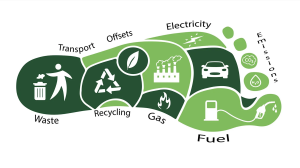In the present day, climate change is one of the biggest challenges we are facing as a species. Human development over the last 200 years has made it so the world is becoming dangerously close to an irreversible change, so it’s no surprise that the topic as a whole can seem overwhelming. While a real solution to this problem will require action on a global scale, there are still choices that every single person can make in their day-to-day life to minimize the damage.
What is a carbon footprint?
A carbon footprint is the amount of greenhouse gas emissions that come from both the production and the consumption of goods and services. While carbon dioxide is the gas most commonly emitted, there are still others, including methane, nitrous oxide, and fluorinated gases, which trap heat in the atmosphere, causing global warming. Generally, the bulk of an individual’s carbon footprint will come from housing, transportation, and food.
Between the seven billion people consuming amounts of the planet’s resources on Earth, the United Nations predicts that the global population will only keep growing at a greater rate. By 2050, there will be 9.7 billion, and over 11 billion by 2100. This rapid increase in population will only drive up emissions and deplete the planet’s resources, and it will have a direct impact on global warming. Thankfully, there are numerous ways your can lessen your carbon footprint to fight global warming, making more eco-friendly choices each day.
Food
One of the first things you can do to decrease your carbon footprint is to reduce your meat and dairy consumption. At least 32,000 million tons of CO2 is released per year due to livestock and their byproducts, which is also 51% of all worldwide greenhouse gas emissions, and it is significantly more than the combined fumes of all modes of transportation. Incorporating more foods such as fruits, veggies, grains, and beans can go a long way in reducing your own carbon footprint. A few other simple ways to be more climate-friendly are to choose organic and local foods that are in season, buy food in bulk, use reusable bags and containers, as well as buy only what you need to reduce waste.
Clothing
The clothing sector generates 10% of all global carbon emissions and remains the second biggest industrial polluter, following the oil industry. In addition to the mass amount of CO2 emissions associated with the production and transportation of fast fashion clothing, it also aids in deforestation on a grand scale. Cheaper fabrics such as rayon, viscose, and modal contribute to over 70 million trees cut each year. These emissions do not even include the water pollution caused by pesticides for the cultivation of cotton. Buying more sustainable, environmentally friendly clothing, or even buying second-hand clothing, will significantly reduce your carbon footprint in the years to come. Even just taking good care of your clothing or washing them using cold water will go a long way.
Transport
As electricity increasingly comes from renewable energy or natural gas, transportation has become a major source of carbon dioxide emissions. Although it varies depending on the car, an average car will produce about five tons of CO2 each year. Something as small as driving less can do much to decrease your carbon emissions, whether it’s by walking, taking public transport, carpooling, or even biking. This is not only a more eco-friendly change, but it also lessens traffic congestion and the idling of engines that accompanies it. Taking care of your car, such as making sure your wheels are properly inflated or the car is maintained can increase your fuel efficiency by 4%. If you are shopping for a new car, I would highly recommend purchasing a hybrid or electric car. Despite the fact that some electric vehicles can cause greater gas emissions, they quickly make up for it in just a few years of use. Overall, experts have broadly agreed that electric vehicles create a lower carbon footprint over the course of their lifetime than do cars and trucks that use traditional engines.
Whether or not you choose to implement any of these changes is up to you, but these day-to-day habits are how even one person can fight a problem as big as climate change. After all, the process of reducing your own carbon footprint will always start with one small step.
Sources:


